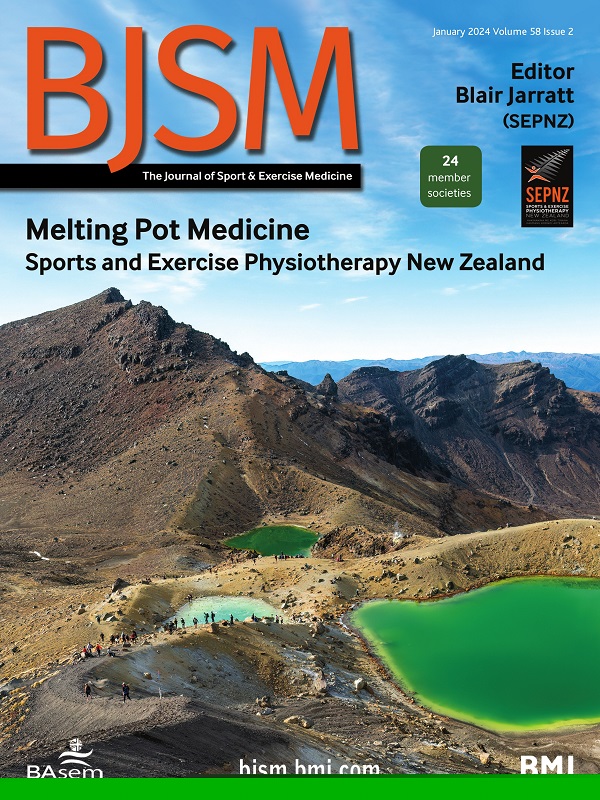Role of movement rate and brain-muscle coupling during high-speed knee movement in hamstring injuries in football (PhD Academy Award)
IF 16.2
1区 医学
Q1 SPORT SCIENCES
引用次数: 0
Abstract
My PhD provided knowledge on the motor control of fast lower limb movements and determined the role of movement rate and the associated brain and muscle activity on football hamstring strain injuries. I measured movement rate, as well as brain and muscle activity, during a maximum-speed repetitive knee flexion-extension task in footballers with and without hamstring strain injury history. To determine whether the differences found were segment-specific, leg and finger movement rate were also compared. Hamstring strain injuries impose an increasing burden on football players and clubs.1 Despite abundant research on hamstring strain injuries, there is a clear lack of evidence on the features of brain activity and brain-muscle coupling in footballers with hamstring strain injury history, especially during high-speed knee movements, which represent a frequent hamstring strain injury mechanism in football.2 As neurophysiological changes have been reported in association with other injuries (eg, ligament injuries),3 hamstring strain injury may drive similar adaptations. The need for further research on hamstring strain injury-related central nervous system adaptations has been highlighted in the latest London International consensus on hamstring injuries.4 Determining the existence of these adaptations contributes to our understanding of the pathophysiology of hamstring strain injuries and their management. The current knowledge on the motor control of fast limb movements was compiled through a narrative review.5 Correct performance in the designed high-speed …运动速率和脑肌耦合在足球腿筋损伤高速膝关节运动中的作用(博士学院奖)
我的博士学位提供了关于下肢快速运动的运动控制的知识,并确定了运动速度和相关的大脑和肌肉活动在足球腿筋拉伤中的作用。我测量了运动速度,以及大脑和肌肉活动,在一个最大速度的重复膝盖屈伸任务中,有或没有腿筋拉伤史的足球运动员。为了确定所发现的差异是否具有节段特异性,还比较了腿和手指的运动速度。腿筋拉伤给足球运动员和俱乐部带来了越来越大的负担尽管对腿筋拉伤的研究非常丰富,但对于有腿筋拉伤史的足球运动员的脑活动和脑肌耦合特征,特别是在高速膝盖运动中,明显缺乏证据,这代表了足球运动中常见的腿筋拉伤机制据报道,神经生理变化与其他损伤(如韧带损伤)有关,3腘绳肌拉伤可能会导致类似的适应。在最新的关于腿筋损伤的伦敦国际共识中,强调了进一步研究与腿筋拉伤相关的中枢神经系统适应性的必要性确定这些适应性的存在有助于我们对腘绳肌腱拉伤的病理生理学及其治疗的理解。对肢体快速运动的运动控制进行了综述正确的性能在设计的高速…
本文章由计算机程序翻译,如有差异,请以英文原文为准。
求助全文
约1分钟内获得全文
求助全文
来源期刊
CiteScore
27.10
自引率
4.90%
发文量
217
审稿时长
3-8 weeks
期刊介绍:
The British Journal of Sports Medicine (BJSM) is a dynamic platform that presents groundbreaking research, thought-provoking reviews, and meaningful discussions on sport and exercise medicine. Our focus encompasses various clinically-relevant aspects such as physiotherapy, physical therapy, and rehabilitation. With an aim to foster innovation, education, and knowledge translation, we strive to bridge the gap between research and practical implementation in the field. Our multi-media approach, including web, print, video, and audio resources, along with our active presence on social media, connects a global community of healthcare professionals dedicated to treating active individuals.

 求助内容:
求助内容: 应助结果提醒方式:
应助结果提醒方式:


